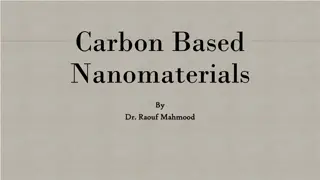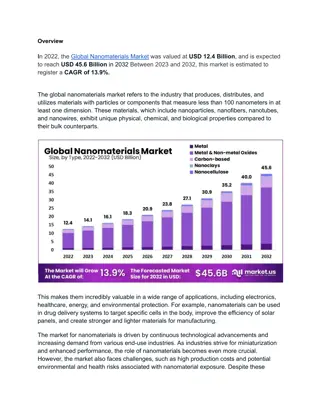North America Leads the Charge in Black Phosphorus Adoption
The black phosphorus market is mainly driven by the increasing demand for gas sensors in critical industries and the implementation of various health and safety regulations globally. The key market players profiled in the report include ACS Material LLC (US), 2D Semiconductors (US), Nanochemazone (
1 views • 3 slides
Understanding Carbon-Based Nanomaterials and Their Technical Applications
Carbon-based nanomaterials, including fullerenes and carbon nanotubes, have revolutionized various industries with their unique properties. These materials, classified based on their geometrical structure, have applications in fields such as electronics, gas storage, biotechnology, and more. Fullere
0 views • 12 slides
Advancements in 2D Nanomaterials Research
Advancements in the field of 2D nanomaterials, beyond graphene and transition metal dichalcogenides (TMDs), have attracted significant attention. Researchers explore various 2D materials with unique properties and applications. The categorization of 2D materials into layered and non-layered structur
0 views • 21 slides
Global Nanomaterials Market: Pioneering the Future of Material Science
Global Nanomaterials Market was valued at USD 12.4 Billion, and is expected to reach USD 45.6 Billion in 2032 Between 2023 and 2032, this market is estimated to register a CAGR of 13.9%.\n
0 views • 5 slides
Troskal Nanoscience
Torskal is a business that specializes in nanotechnology and sophisticated materials. A variety of premium nanoparticles, nanomaterials, and associated products are available from them for use in commercial, industrial, and research applications.
7 views • 8 slides
Colorimetric Detection of Hydrogen Peroxide Using Magnetic Rod-Based Metal-Organic Framework Composites
Nanomaterials, particularly magnetic rod-based metal-organic frameworks composites, are gaining attention for their exceptional properties and various applications in different fields. This study by Benjamin Edem Meteku focuses on using these composites for colorimetric detection of hydrogen peroxid
0 views • 16 slides
Chemical Vapor Deposition (CVD) Methods for Nanomaterials Characterization
Chemical Vapor Deposition (CVD) is a widely used method in the field of nanomaterial synthesis, particularly for growing nanotubes, nanowires, and nanoparticles. The process involves decomposing a gaseous precursor on a substrate with the help of a catalyst, either predeposited or provided in the ga
3 views • 8 slides
Exploring Nanomaterials: Revolutionizing Technology
Nanomaterials represent a groundbreaking technological frontier, allowing for the manipulation of material properties at the molecular level with immense potential across various industries. This seminar delves into the definition, applications, properties, and future prospects of nanomaterials, sho
0 views • 17 slides
Exploring Smart and Composite Materials in Modern Technology
The content delves into the realm of smart and composite materials, highlighting modern advancements and applications such as shape-memory alloys, nanomaterials, photochromic glass, temperature-responsive polymers, and more. It discusses the advantages, disadvantages, and examples of composites like
0 views • 11 slides
Exploring Nanotechnology at Photonics Center - An Introduction to the Nanoscale
Delve into the fascinating world of nanotechnology with Professor Helen Fawcett at the NSF REU and RET at Photonics Center. Discover the significance of a nanometer, compare nanoscale sizes to visible objects, and learn about the wonders of nanotechnology in interdisciplinary science and engineering
0 views • 9 slides
Advancements in Nanomaterials for Building Construction
Addition of nanoscale materials like nano-SiO into cement can enhance compressive strength and pore size distribution in concrete. Carbon nanotubes offer mechanical durability and crack prevention in construction materials. However, the use of nanomaterials in construction is currently limited due t
0 views • 22 slides
Comparative Analysis of Bottom-up and Top-down Nanomaterial Synthesis Techniques
Bottom-up techniques yield individual nanoparticles with narrow size distributions, while top-down methods produce bulk nanostructured materials. Physical Vapour Deposition (PVD) and Inert Gas Condensation (IGC) are examples of bottom-up approaches capable of synthesizing nanomaterials with precise
0 views • 10 slides
Understanding Nanotechnology: A Brief Introduction to the World of Nanotech
Delve into the fascinating realm of nanotechnology through a concise overview provided by Andrew Maynard, an esteemed ASU professor. Explore the innovative possibilities offered by designing materials at the atomic level and the crucial aspect of responsible innovation in dealing with the implicatio
0 views • 13 slides
Exploring Nanoscience and Nanotechnology with Dr. Abeer Alshammari
Delve into the fascinating world of nanoscience and nanotechnology through the elective course PHYS 476 with Dr. Abeer Alshammari. Learn about the unique properties of nanomaterials, including microstructure, defects, dislocations, twins, stacking faults, and more. Discover how nano-dimensions impac
0 views • 10 slides
Understanding Mechanical Properties of Nanostructured Materials
Nanostructured materials exhibit unique mechanical properties due to factors like grain boundary structure and dislocation movement. Reduction in grain size can enhance strength and hardness while reducing ductility. Nanomaterials may reach theoretical strength levels, significantly higher than sing
0 views • 23 slides
Nanomaterial Synthesis Techniques: Ball Milling and Electrodeposition
Ball milling and electrodeposition are top-down approaches for synthesizing nanomaterials. Ball milling involves using small hard balls to crush solid materials into nano crystals, while electrodeposition creates nano films by passing current through electrodes in an electrolyte. These techniques of
0 views • 10 slides
Understanding Classification of Nanomaterials and Quantum Phenomena
Nanomaterials are classified into different types such as nanocrystals and quantum dots, each exhibiting unique properties at the nanoscale. Quantum dots, zero-dimensional systems, show quantum confinement effects leading to tuneable light emission. One-dimensional structures like nanowires and nano
0 views • 18 slides
Applications of Nanomaterials in Medicine and Biology
Nanomaterials play a crucial role in medicine by serving as drug carriers, bioimaging agents, and therapeutic entities due to their unique properties. In biology, nanotechnology is used for tissue regeneration, biomarker identification, and bioimaging of pathological lesions. The applications of nan
0 views • 16 slides
Exploring Nanoscience and Nanotechnology by D. Pegu
Delve into the fascinating world of nanoscience and nanotechnology as explained by D. Pegu, an associate professor at Haflong Govt. College. Learn about the fundamentals of nanophysics, nanomaterials, and nanotechnologies. Discover the impact of nanoparticles on various properties, including melting
0 views • 19 slides


















